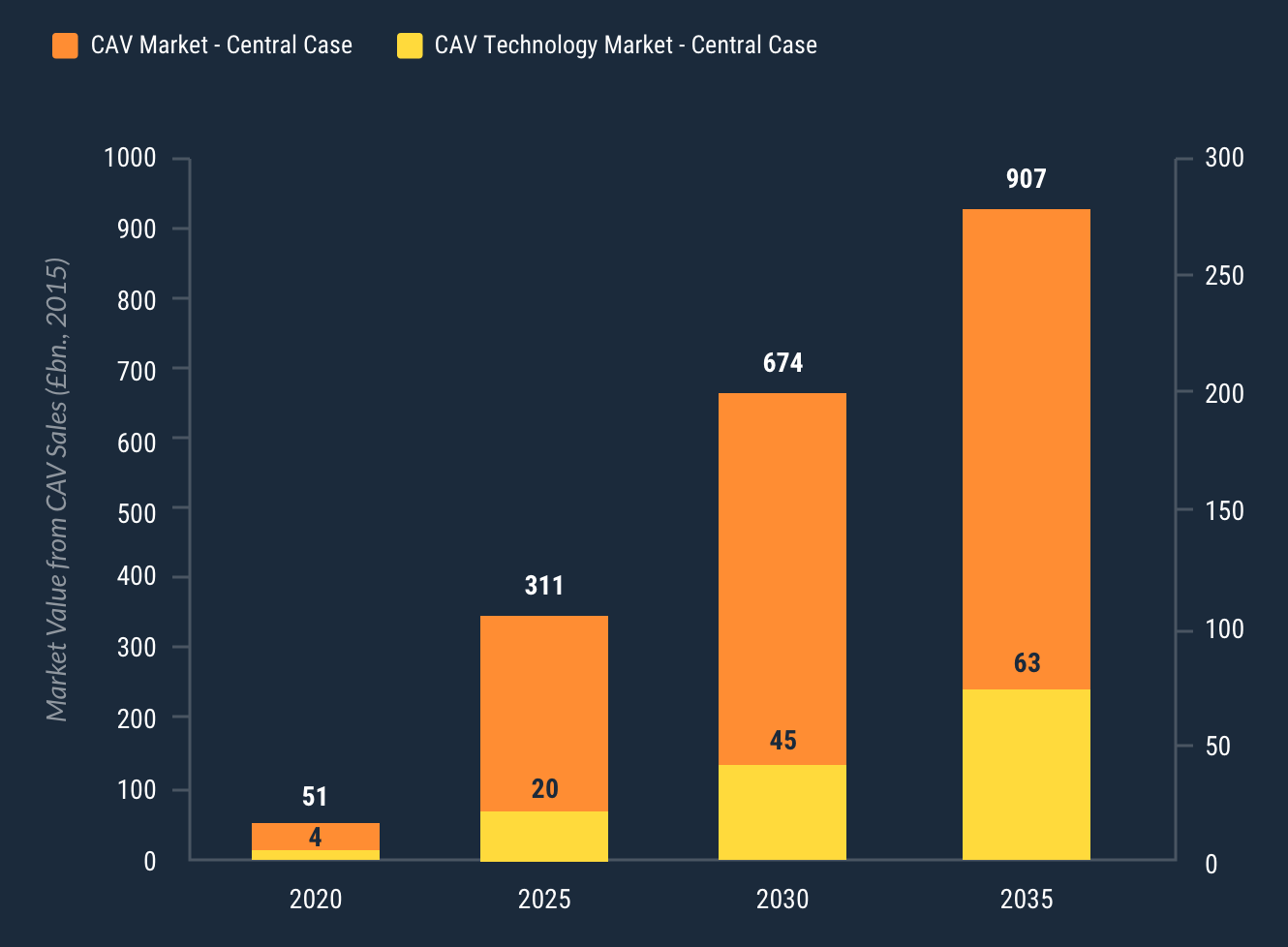Go To Market (GTM)
Technology as a driver of innovation impacts both future product development opportunities as well as emerging business models. Project Alloyed presents an opportunity for the project partners to research and develop valuable contributions to the Connected & Autonomous Vehicles market.
The GTM work package is primarily focused on studying market opportunities and creating product development plans based on concepts and systems developed during the course of the project. In addition, the work package creates a detailed business plan covering products, people, tools and finances required to take project outcomes to market.

Alloyed Market Summary
Connected & Autonomous Vehicle will drive transformational changes while bringing social, economic and industrial benefits to the economies that take the lead in it's adoption.
Automotive executives such as GM Chief Executive Mary Barra believe that the industry will change more in the next few years than it has in the past fifty. As it stands on the cusp of this revolution, the industry faces both the challenges of disruption, and the chance to seize tremendous opportunities.
Drivers - Emergence of cost effective technologies. Increased efficiency in usage of vehicle assets (i.e. more time on the road). The economic opportunity through creation of jobs and local production of hardware and software. Enhanced productivity through the shift from drivers to passengers.
Benefits - New opportunities for adjacent markets such as Insurance, Telecoms, Advertising, Retail & Transportation. Enhanced safety given that 94% of accidents occur due to human error according to UK Department for Transport (DfT) which is now forecast to halve by 2030. Reduced congestion through planned and synchronised routing of traffic. The integration of road, rail, marine and air transport. Support the environment by lowering emissions through advanced technologies. Increase road access for all including the disabled and elderly. The creation of new jobs forecast to reach 320,00 new jobs by 2030 in UK alone.
Business Models & Services - Emergence of new business models such as car sharing & ride sharing. Evolution of the Insurance industry by moving towards usage based insurance. Opportunities for data monetisation through new data exchanges such as for location-based advertising, real-time parking availability and predictive vehicle diagnostics and maintenance.
As of March, 2018, the UK has announced the review of driving laws with a 3-year review to examine any legal obstacles to the widespread introduction of self-driving vehicles and highlight the need for regulatory reforms. Although a critical step forward, the US is already pushing forward an AV Start Act potentially allowing 25,000 autonomous vehicles on US roads which would grow to 100,000 in 3 years. China has also laid out national guidelines for testing self-driving cars as it looks to keep pace with the US in a global race to develop autonomous vehicles
Autonomous vehicles may collect and maintain identifying information about the owner or passenger of the vehicle for a variety of purposes, such as to authenticate authorised use, or to customise comfort, safety, and entertainment settings. This information likely will be able to identify owners and passengers and their activities with a high degree of certainty. A number of government & industry initiatives are underway to address issues in this area including the use of the Privacy by Design approach and Consumer Protection Principles however in the short term GDPR (e.g. user consent) and data anonymisation is likely to be most adopted to quell consumer concerns.
Vehicle and Infrastructure operators and technology producers have been privy to data from these entities in the past. With the promise of new services, on the basis of what is now also user data, these entities must now find ways to mark data, seek permission on usage and potentially share in revenues generated from the data.
Typically liability falls on owners of vehicles (i.e. individuals & organisations) however with the introduction of Autonomous Vehicles greater proportions of liability will fall to commercial organisations and away from individuals.
A detailed analysis of the market is followed by dissecting market data to understand where market opportunities exist for partners within the project consortium. As an example, an area of focus could be V2X hardware and software as a basis for expansion into adjacent opportunities. Through the development of the software V2X stack and related hardware components during the course of the project, approximately 15% of the the total CAV technology stack can be targeted with a build case based on short-term customer engagement and a view to longer term market penetration.

Project Global CAV & CAV Technology Market Value
A simple analysis of technology package yield from total CAV sales presents a £4B and £20B CAV technology market in the years 2020 and 2025, respectively. The addressable opportunity for V2X hardware and software at Autonomy L3 in 2020 presents a total market size of £600m in 2020 and £2B in 2025. The market will evolve over this period and any attempts to enter and grow with the market require players to be adaptable and forward-thinking.

Estimated breakdown of Autonomy package costs at component level
The project outcomes identified present a number of potential opportunities for pursuit. These are prioritised based on innovation factor, relative ease of access, development costs and market interest. The products identified have development plans documented based on use-cases developed in work package 2 together with their systems requirements. The detailed systems requirements have allowed the team to plan around a minimum viable product with product roadmaps in place.
In addition to the work described, the project team has evaluated different business models and built a plan covering -
- Product Concepts
- Value Propositions
- Positioning Guidelines
- Pricing
- Customer Segmentation & Pipeline
- Channels & Partnerships
- Marketing Plan
- Service & Support Model
These are coupled with resource and financials requirements with a plan to take products to market.
Led By

Partners


Led By

Partners

